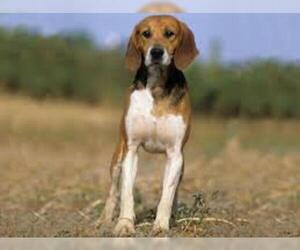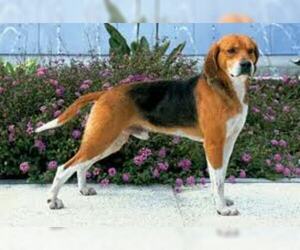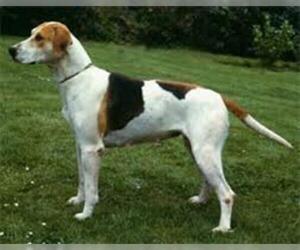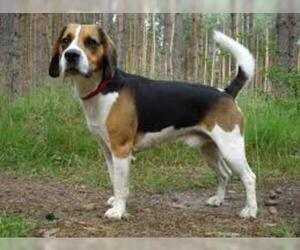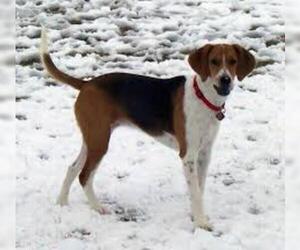All about Harrier dog breed
A.K.A. :Harehound, Harrier Hound, English Harrier
Size
Grooming requirements
Exercise requirements
Good with other dogs
Watchdog ability
Energetic
Training requirements
Playful
Affectionate
Good with other pets
Good with children
Good with strangers
Winter
Summer
Healthiness
Protective
Life Span
| Pure Breeds | Member |
| Breeds A - Z | H |
| Breeds by Group | Hound Scenthound |
| Breeds by Trait | Fast Dog Breeds High Stamina Dog Breeds |
| Overview: | The Harrier, a medium-sized scent hound originating from England, was primarily bred for hunting hare, hence its name. Physically, they present a sturdy and athletic build, typically standing 19-21 inches tall and weighing between 45-60 pounds. Their short, dense coat is usually tricolor (white, black, and tan) or lemon and white, requiring minimal grooming. Harriers possess a generally friendly and outgoing temperament, characterized by their energetic and curious nature. They are known for being quite vocal, emitting a distinct "bay" when excited or tracking a scent. While intelligent, their independent streak means training requires patience and consistency. Due to their high energy levels and strong prey drive, they thrive in active homes with securely fenced yards and are generally good with children and other dogs when properly socialized. However, their need for significant exercise makes them less suitable for apartment living. As a relatively healthy breed, Harriers can be prone to common canine ailments such as hip and elbow dysplasia, as well as certain eye conditions. Potential owners should research responsible breeders and understand the breed's need for mental and physical stimulation to ensure a happy and healthy companion. |
F.A.Q.
All You Need to Know About the Harrier Breed
The Harrier is a charming and versatile medium-sized hound, originating from England where they were bred for hunting hare. Known for their friendly, outgoing, and energetic temperament, Harriers are excellent companions for active families. They typically weigh between 45-60 pounds and possess a sturdy, athletic build with a short, dense coat usually in tricolor or lemon and white. While generally good with children and other dogs, their strong prey drive means they might not be suitable for homes with small pets without early socialization. Harriers are not ideal for apartment living due to their high energy levels and need for ample space to run and explore. They require moderate grooming—weekly brushing suffices—but demand significant daily exercise to prevent boredom and destructive behaviors. Common health considerations include hip and elbow dysplasia and eye conditions. Potential owners should be prepared for a vocal breed that thrives on companionship and outdoor activity.Harrier Weight: Average Size & Healthy Weight for Harrier
The average weight for an adult Harrier typically ranges from 45 to 60 pounds. While there isn't a significant size disparity, males tend to be on the higher end of this range, often weighing between 50-60 pounds, while females usually fall between 45-55 pounds. This is considered a healthy weight for Harrier, ensuring they are agile and fit for their active lifestyle.Curious about a Harrier's height? You've come to the right place! Understanding a breed's dimensions is important when considering a new companion.
What is the average height of a Harrier in inches?
The average size of an adult Harrier, measured at the shoulder, is typically between 19 and 21 inches.This means the average height falls right in the middle, around 20 inches. Harriers are known for their sturdy, athletic build, perfectly sized for their original purpose as hunting dogs.Typical Adult Height Range (at the Shoulder):
- 19 to 21 inches
Variation Based on Gender or Genetics:
While the overall range is quite consistent, you might observe slight variations:- Gender: Male Harriers tend to be at the upper end of the spectrum, sometimes reaching the full 21 inches, while females might be closer to the 19-inch mark. However, these are general trends, and there can be overlap.
- Individual Genetics: Just like people, individual Harriers can have slight differences based on their genetic lineage. Some may be naturally a little taller or shorter within the accepted breed standard. Always consider the full range when asking, "how tall is a Harrier?"
The Harrier colors are traditionally tricolor (black, tan, and white) and lemon and white. These are the most commonly seen and AKC recognized Harrier colors. While these are the standard, other variations can occur, though they are not accepted by major kennel clubs. These include bicolor combinations like black and white or tan and white. Rare Harrier coat types and exotic Harrier variations such as solid colors, brindle, or merle are not standard to the breed and are not recognized for show, often indicating mixed heritage rather than purebred Harrier lineage. When seeking a purebred Harrier, expect the classic tricolor or lemon and white. Buyers interested in non-standard Harrier coat colors should be aware that these are highly unusual for the breed and are not accepted by kennel clubs for showing or breeding purebred Harriers.
The Harrier personality is characterized by an active, friendly, and good-natured disposition. Harriers are generally very loyal to their families and possess a strong pack instinct, making them highly sociable with both humans and other dogs. Their temperament of Harrier is cheerful and even-tempered, though they can be quite energetic. While adaptable, they are not ideally suited for apartment living due to their need for regular exercise and a tendency to vocalize. They are typically excellent with children, displaying patience and a playful spirit, and usually coexist well with other pets, especially if raised together. Early socialization is key to nurturing their naturally friendly nature.
The Harrier temperament is generally described as friendly, outgoing, and sociable. Harriers are loyal companions that thrive on human interaction and form strong bonds with their families. They are typically good with respectful children, often enjoying playtime, and generally get along well with other dogs due to their pack heritage. While they possess an adaptable nature, their high energy levels and need for exercise make them less suited for apartment living unless their activity needs are consistently met. Potential owners should be aware that Harriers can exhibit a degree of stubbornness, a common trait in scent hounds, requiring consistent and patient training. They are not known for being overly sensitive, but positive reinforcement methods are most effective. With proper socialization and training, they make wonderful, affectionate companion dogs.
Harrier Care: Daily Maintenance & Health TipsHarrier care is generally straightforward, making them a good choice for active families. Their short, dense coat requires minimal grooming; a quick brush once or twice a week is usually sufficient to remove loose hair and keep it healthy. Harriers are *not* a low-energy dog breed despite their calm demeanor indoors. They need substantial daily exercise – at least 60-90 minutes of vigorous activity like running, hiking, or long walks to prevent boredom and maintain their muscular build.Dietary considerations are crucial for Harriers. They are prone to weight gain, so a high-quality, balanced diet fed in controlled portions is essential. Avoid free-feeding. While Harriers are not truly brachycephalic, they do have a somewhat broader muzzle than some other hounds. However, they are generally not sensitive to extreme climates, though they should always have access to shade and water in hot weather.Regular dental care for Harrier is vital; daily brushing or dental chews can help prevent periodontal disease. Check their ears weekly for redness, odor, or discharge, cleaning gently with a veterinarian-approved solution if needed. Harriers are generally a robust breed, but common health concerns include hip and elbow dysplasia, eye conditions, and hypothyroidism. Skin issues can occur, so regular checks for irritations or allergies are important. Weight management is a key aspect of how to care for a Harrier to prevent joint problems and other health complications. Regular vet check-ups are essential for early detection and prevention of these issues.
Harrier Activity Level: How Active Are Harriers?The Harrier is a moderately active breed, known for their enthusiastic bursts of energy balanced with significant periods of rest. Understanding the Harrier activity level is crucial for potential owners. They are not as relentlessly energetic as some other hound breeds, but still require consistent exercise to stay healthy and happy.Typical Energy Levels & Daily Exercise Needs:Harriers possess a good deal of stamina, reflecting their hunting heritage. They typically need at least 60-90 minutes of vigorous exercise daily. This isn't just a leisurely stroll; it needs to be an activity that allows them to run, explore, and use their keen sense of smell. Think long walks, jogs, securely fenced yard play, or even hiking. Without adequate exercise, Harriers can become bored and exhibit undesirable behaviors such as excessive barking or destructive chewing.Playtime Preferences:Harriers love interactive playtime. They enjoy games of fetch, chase, and especially anything that engages their nose, such as scent work or hide-and-seek with treats. They are very social and enjoy playing with their human family members and other dogs. Their playful nature makes them a joy to interact with.Limitations Due to Brachycephalic Anatomy:While Harriers are energetic, it's important to note their slight brachycephalic (short-nosed) anatomy. This can make them more susceptible to overheating, especially in hot or humid weather, or during intense, prolonged exercise. Owners must be vigilant and avoid strenuous activity during peak heat, always ensuring access to fresh water and shade. Monitor their breathing closely and know the signs of heatstroke. This is a key consideration when planning their exercise needs.Suitability for Families & Households:Harriers can be an excellent fit for active families who enjoy outdoor activities and can commit to their daily exercise requirements. Their friendly and outgoing nature makes them wonderful companions for children, provided both are taught to interact respectfully. However, they are generally not suitable for low-energy households or those living in small apartments without easy access to a safe outdoor space for exercise. While they enjoy their downtime and can be calm indoors after a good workout, they are not a "couch potato" breed without that outlet. Proper understanding of the Harrier activity level is vital for a harmonious home.
Breed Breakdown: What Experts Say About the Harrier
I would rate the "Size" trait of the Harrier breed a 6 out of 10.Harriers are a medium-sized breed, distinctly larger than a Beagle but smaller than a Foxhound. They typically stand between 19 and 21 inches tall and weigh anywhere from 45 to 60 pounds. Their body structure is sturdy and athletic, built for endurance and hunting. When compared to the vast spectrum of companion dogs, they fall squarely in the middle: they're not a diminutive lap dog, nor are they a giant breed that fills a room. This moderate size means they are generally not ideally suited for apartment living unless those apartments are exceptionally spacious and the owners are committed to providing significant daily exercise outdoors. While they can travel, their size makes them too large for most in-cabin flights and requires a substantial crate for cargo travel. They are best suited for households with at least a moderate amount of space, ideally with a fenced yard, where they can expend their considerable energy.
I would rate the Harrier's grooming requirements as a 3.Harriers are relatively low-maintenance when it comes to grooming. Their short, dense, and weather-resistant coat sheds moderately, typically requiring only a weekly brush to remove loose hair and keep it healthy. They don't have long feathering or a double coat that needs extensive de-shedding or professional stripping. They generally don't have skin folds that require special cleaning to prevent irritation. Their ears should be checked weekly and cleaned as needed, particularly given their floppy nature, but this is a standard practice for many breeds and not unusually difficult. Nail trimming is a regular necessity for all dogs and not unique or more frequent for Harriers. Bathing is only needed occasionally, when they get particularly dirty, rather than on a strict schedule. They are not known for being overly susceptible to skin issues or allergies compared to other companion breeds. Overall, their grooming is straightforward and manageable for most owners, requiring basic, consistent care rather than frequent, specialized attention.
I would rate the Harrier's "Exercise Requirements" at a 7 out of 10.Harriers are scent hounds bred for hunting, and their physical capabilities reflect this heritage. They possess a robust build, incredible stamina, and a high energy level that demands significant daily activity. While not as relentlessly energetic as some working breeds, they are far from couch potatoes. They thrive on structured routines that include sustained movement, such as long daily walks, jogs, or runs. Their excellent scenting abilities also make them ideal for activities like scent work or tracking, which provide both physical and mental stimulation. Playtime in a secure, fenced yard is also crucial, as they love to run and explore.Unlike some brachycephalic breeds, Harriers are mesocephalic (medium-headed) and do not typically suffer from the same respiratory limitations, allowing them to engage in more vigorous and prolonged exercise without undue stress. They are perfectly suited for long hikes and can maintain a good pace for extended periods. Without adequate exercise, Harriers can become bored, destructive, and prone to weight gain. They require consistent effort from their owners to ensure they remain healthy, happy, and well-behaved, and will not thrive with minimal activity. They are a good fit for active individuals or families who enjoy outdoor activities and can provide them with the necessary outlets for their boundless energy.
I'd rate the Harrier's "Watchdog Ability" at a 6 out of 10.While Harriers are generally alert dogs with good hearing, they aren't typically known for being fiercely protective or territorial. Their "watchdog" capabilities stem primarily from their tendency to bark and make noise when something unusual is happening, whether it's a stranger approaching the house or a squirrel in the yard. They'll certainly let you know that *something* is up, providing meaningful early warnings through their vocalizations. However, their response to unfamiliar people is more likely to be one of curiosity and a desire to investigate, rather than an aggressive or deterrent posture. They're not generally inclined to act as a physical barrier or to actively "deter" an intruder beyond their initial noisy announcement. They are more of an active, vocal companion that will alert you to changes in their environment, rather than a breed with strong guarding instincts.
I would rate the "Good with Other Dogs" trait of the Harrier breed as an 8 out of 10.Harriers are generally very sociable and friendly dogs, a direct reflection of their history as pack hounds. They thrive in canine company and are typically very tolerant of other dogs, often enjoying play and interaction. This makes them well-suited for multi-dog households. They usually adapt well to dogs of different sizes and energy levels, often adjusting their play style to match. While a strong prey drive means careful introductions are always a good idea with small, prey-like animals, their interactions with other canines are usually amicable. Like all dogs, early socialization is beneficial to reinforce their naturally good temperament, but Harriers are less prone to aggression or dominance with other dogs than many breeds. While no dog is a guaranteed perfect fit, their pack-oriented nature predisposes them to coexist peacefully and even joyfully with other canine companions.
I would rate the Harrier breed's "Energetic" trait at an 8 out of 10.Harriers are remarkably active and hardy dogs, bred for the demanding work of hunting hare over long distances. They possess impressive endurance and a natural inclination for physical exertion. Their typical activity level is high, requiring significant daily exercise to keep them content and prevent destructive behaviors. They are inherently playful and thrive on engagement, often seeking out opportunities for running, chasing, and exploring. Their need for physical stimulation is considerable; they are not dogs content with short walks around the block. Harriers excel in outdoor and athletic activities, enjoying hiking, jogging, and dog sports like agility or lure coursing. Compared to many other companion dogs, they are decidedly on the active and robust side, with a stamina that belies their medium size. It's important to note that while some sources might mistakenly associate the term "Harrier" with brachycephalic breeds, the Harrier is a distinct scent hound breed with a classic dolichocephalic (long-nosed) head structure. This means their anatomy does not negatively impact their stamina or exercise tolerance; in fact, their excellent respiratory capacity is a key component of their exceptional endurance.
I'd rate the Harrier's training requirements a 7 out of 10.Harriers are intelligent hounds, but their independence and strong prey drive present significant training challenges. While they are capable of learning, their attention span can be fleeting when an interesting scent is present, making consistency paramount. They are generally not stubborn in the same way some terriers can be, but their inherent desire to follow a trail often overrides a human's command. Responsiveness to commands will vary greatly depending on the environment and the dog's focus; off-leash reliability, especially in open areas, is particularly difficult to achieve. Positive reinforcement is effective, as they are food-motivated and eager to please *when they choose to be*, but it needs to be delivered quickly and consistently to capitalize on their short attention span.This breed is not beginner-friendly when it comes to training. They require experienced handling, a deep understanding of hound behavior, and structured, routine training sessions that begin early in life and continue throughout their adolescence. Owners must be patient, persistent, and prepared for a dog that will often prioritize its nose over its handler's voice.
I would rate the Harrier's "Playful" trait a solid 8 out of 10.Harriers are naturally spirited and possess a high degree of enthusiasm, making them exceptionally fun-loving. Their activity level is high; they thrive on physical engagement and games, exhibiting a genuine love for interaction. They are not typically laid-back and will readily instigate playtime, often displaying a lively attention-seeking behavior through nudges or bringing toys. Their response to toys and opportunities for play is enthusiastic and often accompanied by their characteristic baying. They are always ready for an adventure, and their overall zest for life translates into a consistently playful demeanor, though perhaps not quite as intensely "on" as some of the hyper-active terrier breeds, they are still far from inactive.
I'd rate the Harrier's "Affectionate" trait a 7 out of 10.While not typically known as extreme lapdogs like a Cavalier King Charles Spaniel, Harriers are far from emotionally distant. They possess a strong desire for human companionship and are quite loyal to their families, often following them from room to room. They enjoy being part of the family "pack" and will readily seek out attention and affection, often nudging for pets or leaning against their owners. They are generally sensitive to owner emotions and will respond to praise and comfort. However, their hunting instincts and independent streak mean they aren't always seeking constant physical closeness, and they might prefer to be near you rather than directly on your lap for extended periods. They thrive on affection and inclusion but possess a more robust, active nature compared to more traditional "velcro" companion breeds, meaning they also appreciate opportunities for independent exploration and play. They are loving and devoted without being overly clingy.
I would rate the "Good with Other Pets" trait of the Harrier breed as a 7 out of 10.Harriers were bred to hunt in packs, which inherently makes them very sociable with other dogs. They typically thrive in multi-dog households and enjoy the companionship of canine friends, often displaying playful and cooperative behavior. This pack mentality means they're usually not prone to resource guarding with other dogs, as sharing and working together are part of their nature.However, their strong prey drive, stemming from their hunting heritage, is a significant factor when considering compatibility with smaller, non-canine pets like cats, rabbits, or birds. While some Harriers, especially if raised with cats from a young age and properly socialized, can learn to coexist peacefully, it often requires consistent training and supervision. Their instinct to chase can be powerful, and it's not a trait that can be entirely extinguished. Adaptability in multi-pet households *can* be high, but it largely depends on the specific other pets and the dedication to socialization and training. With cats, for instance, a Harrier might see them as something to chase rather than a housemate without careful management. Therefore, while they are naturally sociable with other dogs, their compatibility with other types of pets requires more work and vigilance due to their inherent hunting instincts.
The Harrier breed rates a 6 out of 10 for "Good with Children."Harriers are generally good-natured and enjoy being part of the family, which includes children. Their playful and energetic nature can make them fun companions for older, more robust children who understand how to interact with a dog. They are often quite patient and can tolerate the noise and activity that comes with a bustling household.However, their strong prey drive and high energy levels mean they aren't always naturally gentle or instinctively cautious around very young children. They can be boisterous and might accidentally knock over a small child in their excitement. While they are not typically aggressive, their vocal nature (baying) can be startling to some children, and their need for consistent exercise and mental stimulation is crucial to prevent boredom-induced behaviors that might not be ideal in a family setting. Therefore, while trainable and generally affectionate, Harriers thrive best with families willing to provide clear boundaries, consistent training, and active supervision, especially around toddlers, to ensure a harmonious environment for everyone. They are more suitable for families with slightly older children who can engage in play and understand dog etiquette, rather than being a breed that is universally gentle and instinctively safe with all ages without effort.
I'd rate the "Good with Strangers" trait of the Harrier a 7 out of 10.Harriers are generally quite sociable and friendly, especially if well-socialized from a young age. They are not typically aggressive or overly reserved with unfamiliar adults. Their pack hound nature means they enjoy company and are usually quite amenable to new people. However, they aren't quite a 10 because while friendly, they possess a strong prey drive and an independent streak that means their primary focus might not always be on greeting every stranger with unbridled enthusiasm. They are more likely to be curious and accepting rather than overwhelmingly effusive. They don't typically bark excessively at strangers unless there's a perceived threat, and guarding is not a primary trait. They adapt reasonably well to public or guest-filled environments once they understand they are part of the "pack" activity, but their independent hunting instincts mean they might occasionally be distracted. They are naturally outgoing but benefit greatly from early and consistent socialization to reinforce their comfort and good manners around new people.
I would rate the Harrier's "winter" tolerance at a 6.Harriers are generally quite robust and energetic, but they aren't built for extreme cold. Their coat is short and dense, providing some insulation, but it lacks the thick undercoat of breeds designed for very cold climates. They are medium-sized and athletic, with a moderate amount of body fat, which helps a bit, but they aren't particularly large or heavily muscled to generate and retain a lot of heat. Importantly, Harriers are *not* brachycephalic, so they don't have the respiratory challenges that can make cold weather dangerous for flat-faced breeds.While a Harrier can tolerate and enjoy outdoor activity in moderately cold temperatures for reasonable periods, especially if they are actively running and generating body heat, they are susceptible to hypothermia if exposed to very low temperatures, wind, or wet conditions for extended periods. They will definitely require special care during winter months compared to other companion dogs that are naturally more insulated, such as a Siberian Husky or Newfoundland. This means shorter outdoor sessions in very cold weather, especially if not actively exercising, and providing a warm, dry shelter. A winter coat or sweater would be a beneficial addition for walks in frigid temperatures, and their paws should be protected from ice and salt. They aren't as delicate as a Toy Poodle, but they are far from a polar breed.
Harrier "Summer" Tolerance Rating: 4Harriers, while not as severely brachycephalic as some other breeds, do possess a somewhat shorter muzzle compared to their longer-nosed counterparts. This anatomical feature, combined with their dense double coat, makes them moderately sensitive to heat. They are not as adept at regulating body temperature as breeds with longer muzzles and single coats, making them more susceptible to overheating and heatstroke. Their energy levels typically necessitate regular outdoor activity, but during hot weather, this needs significant modification. Owners must exercise extreme caution, limiting outdoor time to early mornings or late evenings when temperatures are cooler. Vigorous activity should be strictly avoided. Harriers will require access to cool, air-conditioned indoor environments during peak summer heat to prevent heat-related illnesses. Compared to many other companion dogs, particularly those with single coats or less dense fur, Harriers absolutely require special care in the summer months to ensure their well-being and prevent potentially life-threatening heatstroke. They are not a breed that can simply "tough it out" in hot weather.
I would rate the Harrier breed's "Healthiness" trait as an 8.Harriers are generally considered a robust and healthy breed with a good life expectancy of 12-15 years. They are not typically plagued by the extensive list of severe genetic predispositions seen in some other breeds. Unlike brachycephalic (short-nosed) breeds, they do not suffer from inherent breathing difficulties. While like many medium to large breeds, they can be susceptible to hip and elbow dysplasia, responsible breeders actively screen for these conditions, and the incidence is not excessively high. They are also less prone to the chronic skin conditions or specific heart problems that afflict certain other breeds. While bloat (gastric dilatation-volvulus) is a concern for all deep-chested dogs, it's not uniquely prevalent in Harriers. Compared to many companion dogs, they are generally not high-maintenance in terms of health, often requiring standard veterinary care and preventative measures. Their overall hardiness and relatively few breed-specific health issues contribute to this excellent rating.
I would rate the "Protective" trait of the Harrier breed as a 3.While Harriers are known for being alert and will certainly bark at unusual sounds or strangers approaching, making them good at announcing a presence, their territorial instincts are not strongly geared towards active defense. They are highly social and generally friendly, which means that while they will initially react to a stranger, that reaction is more likely to be one of curiosity or a desire to investigate rather than aggression or a need to protect. Their loyalty to owners is strong in the sense of being a devoted companion, but this doesn't translate into a strong protective drive against perceived threats. They are definitely more of a companion dog than a watchdog or guard dog capable of offering meaningful physical protection in a household setting. Their size and powerful bark might deter some, but their inherent good nature means they are unlikely to follow through with any truly protective actions.
I would rate the "Life Span" trait of the Harrier breed a 7 out of 10.Harriers are generally considered a long-lived breed when compared to many other companion dogs. With an average life expectancy typically ranging from 12 to 15 years, they often outlive several other medium to large breeds. While they are not entirely free from health concerns, common issues like hip and elbow dysplasia, eye conditions, and hypothyroidism are often manageable with responsible breeding practices and proper veterinary care. They don't typically suffer from a high prevalence of rapidly progressive or early-onset fatal genetic predispositions that plague some breeds. Their robust nature and moderate size contribute to their extended lifespan, and good nutrition, regular exercise, and preventative care can significantly enhance their longevity. They are not in the "exceptional longevity" category like some toy breeds, but they comfortably exceed the average for most dog breeds.
Harrier Dogs for adoptionSee all dogs for adoption
Similar Dog Breeds for Harrier
Breed Mixes of Harrier
Quick Breed Selector 0 - not important, 1 - smallest, 10 - largest
Variants & Mistakes :Hariier, Harire, Harreir, Harrieer, Harier, Harriar, Harrer, Harri, Harryer, Haraier, Harair, Hareier, Hareir, Harrayer, Harrayr, Harreyer, Harryr, Haryer, Herrier, Harir, Harrrier, Harrie, Hari, Harray, Harey, Hary, Heraier, Herair, Hereier, Hereir, Herreir

